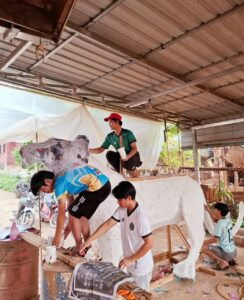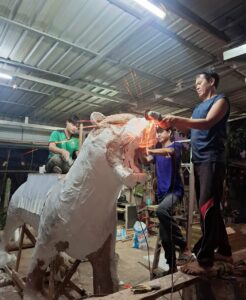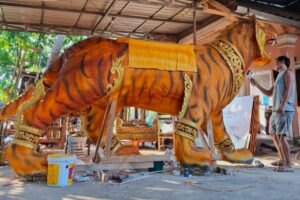Luang Prabang celebrated Pi Mai Lao, or Lao New Year, with its traditional Nang Sangkhan Procession. Central to the event is Miss Lao New Year, who rides through the city’s streets atop a symbolic animal.
This year, a tiger led the way, replacing last year’s peafowl. The replica was once again created by the young team of Ounhuean “Odd” Phommany, a local artisan now aged 55.
Commissioned by the Luang Prabang Provincial Office, Odd and his team had just two weeks, from 28 March to 8 April, to complete the build.
“They were certainly impressed with what we did last year with the peafowl, so they trusted us with another task this year,” Odd said, reflecting on his second consecutive commission for the parade.
Family Affair and Labor of Love
Odd’s team this year consisted of six people, just like last year. Among them were three of his younger brothers and three friends of his son, all fine arts enthusiasts. His son, although not directly involved, played a key role by connecting his friends to the project.
“My son’s got a separate job of his own, so he couldn’t join us, but he sent some of his art-loving friends my way,” Odd said.


Working tirelessly from 8 am to 11 pm each day, with only short breaks for meals, the team poured heart and soul into the tiger’s construction.
Despite the tight schedule, Odd noted that building the tiger replica was less complicated than the peafowl, thanks to its simpler design and more compact .
“A peafowl has so many tiny details and is much taller, which made it a lot harder last year. The tiger, by comparison, is simpler,” he explained.
The team utilized a combination of wood, foam, and newspaper to shape the tiger, making the construction and painting process more manageable.
As of early April, the replica was 99 percent complete—only final polishing remained before the provincial authorities arrived to attach it to a moving vehicle for the dual parades scheduled on 14 and 16 April.
Short Timeline, Limited Pay
Despite their dedication, Odd expressed frustration over the short notice and tight timeline, wishing they had been informed at least a month in advance.

“We had to push ourselves really hard to meet the deadline.”
Adding to the pressure was the payment: LAK 65 million (USD 2,999)—the same amount they received for last year’s more labor-intensive peafowl.
“It didn’t really cover the whole thing. Some of the team were hoping for at least LAK 71 million (USD 3,276.73) this time,” Odd admitted. “But at the end of the day, we ain’t got no choice but to accept the offer anyway, out of our love for crafting.”
Although unsure of the religious symbolism of his creation, Odd takes deep pride in the cultural and communal significance of his work.
And when asked whether he’d take on the challenge again next year, he said, “Definitely, though I’d want to negotiate a better timeline.”
From Reluctant Student to Master Artisan
Odd’s journey into the world of craftsmanship began not out of personal ambition, but at the urging of his parents.
“Surprisingly, the passion for crafting didn’t start within me. It was my parents who made me go to Luang Prabang Fine Arts School,” he recalled, explaining that he had to enroll right after finishing middle school, when he was only 15.
“They said they saw potential in me, although I had absolutely no idea.”
He spent three years at the Luang Prabang Fine Arts School, followed by another three at a similar institution in Vientiane Capital. After graduating, Odd spent two more years in the capital working as a silver forger before returning to his hometown in 1994 to begin his artisan career in earnest.
His talent quickly gained recognition, particularly through Luang Prabang’s annual boat lantern competition, a cultural event where teams craft intricate, illuminated boats and parade them through town.
“Whenever I participated in one, my group always won first place,” he said proudly.
Background on Miss New Year Animal
From peafowl to tiger, Odd Phommany’s hands continue to shape Luang Prabang’s festive spirit.
Each year, the animal that carries Nang Sangkhan reflects one of the seven daughters from Lao mythology, each representing a day of the week and rotating annually to guide the theme of the procession.
This year’s tiger pays tribute to Nang Kholaka Thevi, the daughter associated with Monday.
She is often depicted riding a tiger, wielding a sword in her right hand and holding a cane in her left. Her fierce and protective image symbolizes strength and guardianship for the year ahead.
She is one of seven mythic daughters, each representing a day of the week in Lao tradition. Nang Thoungsa Thevi, the daughter of Sunday, is shown riding a mythical Garuda, carrying a discus and a conch shell, symbols of divine power and protection.
On Tuesday, Nang Haksod Thevi takes center stage. She rides a pig and is armed with a trident and bow, signifying battle readiness and determination.
Nang Montha Thevi, the Wednesday daughter, travels on a donkey while holding a staff and crook. Her gentle yet steady presence represents wisdom and patience.
Thursday’s Nang Khilini Thevi rides an elephant, equipped with an elephant hook and a gun, icons of leadership and control over powerful forces.
On Friday, Nang Khimita Thevi appears on a buffalo, carrying both a sword and a lute. She embodies both strength and harmony, blending the warrior and the artist.
Finally, Nang Mahothone Thevi, the daughter of Saturday, rides a peacock while holding a discus and trident. Her vibrant image reflects beauty paired with divine justice.



